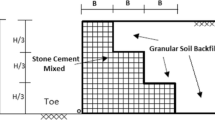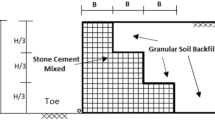Abstract
An important task of geotechnical engineering is a suitable design of safety factor (SF) of retaining wall under both static and dynamic conditions. This paper presents the advantages of both prediction and optimization of retaining wall SF through artificial neural network (ANN) and artificial bee colony (ABC), respectively. These techniques were selected because of their capability in predicting and optimizing science and engineering problems. To gain purpose of this research, a comprehensive database consisted of 2880 datasets of wall height, wall width, wall mass, soil mass and internal angle of friction as input parameters and SF of retaining wall as output was prepared. In fact, SF is considered as a function of the mentioned parameters. At the first step of modeling, several ANN models were constructed and the best one among them was selected. The coefficient of determination (R2) value of 0.998 for both training and testing datasets was obtained for the best ANN model which indicates an excellent accuracy level in predicting SF values. In the next step of modeling, the results of selected ANN model were used as an input for the optimization technique of ABC. In general, 11 models of ABC optimization with different strategies were built. As a result, by decreasing wall height value from 10 m to 8 m and 5.628 m and using almost constant values for the other input parameters, SF values were obtained as 2.142 and 5.628, respectively. Results of (8.003, 0.794, 0.667, 1800 and 2800) and (5.628, 0.763, 0.660, 1735 and 2679) were obtained for wall height, wall width, internal friction angle, soil mass and wall mass of the best models with 2.142 and 5.628 SF values, respectively.










Similar content being viewed by others
References
Coulomb CA (1776) “Essai sur une Application des Règles de Maximis et Minimis à Quelques Problèmes de Statique Relatifs à L’Architecture,” Mèmoires de la Mathèmatique et de Phisique, présentés à l’Académie Royale des Sciences, par divers savans, et lûs dans sés Assemblées. Annee 1793:343–382
Rankine WJM (1857) On the mathematical theory of the stability of earthwork and masonry. J Franklin Inst 63:84–85
Terzaghi K (1943) Theoretical soil mechanics. Wiley, New York
Leshchinsky D, Vulova C (2001) Numerical investigation of the effects of geosynthetic spacing on failure mechanisms in MSE block walls. Geosynth Int 8:343–365
Yu G-Y, Bai Y-S, Sheng P, Guo R-P (2009) Mechanical performance of a double-face reinforced retaining wall in an area disturbed by mining. Min Sci Technol 19:36–39
Chan YC (1996) Study of old masonry retaining walls in Hong Kong. Geo Report No. 31, Geotechnical Engineering Office, Civil Engineering Department, The Government of Hong Kong, Special Administrative Region, 1996, reprinted 2000
Rankine WJM (1857) On the stability of loose earth. Philos Trans R Soc Lond 147:9–27
Tsagareli ZV (1965) Experimental investigation of the pressure of a loose medium on retaining walls with a vertical back face and horizontal backfill surface. Soil Mech Found Eng 2:197–200
Chang M-F (1997) Lateral earth pressures behind rotating walls. Can Geotech J 34:498–509
O’Neal TS, Hagerty DJ (2011) Earth pressures in confined cohesionless backfill against tall rigid walls—a case history. Can Geotech J 48:1188–1197
Iskander M, Chen Z, Omidvar M et al (2013) Active static and seismic earth pressure for c–φ soils. Soils Found 53:639–652
Armaghani DJ, Hasanipanah M, Mohamad ET (2016) A combination of the ICA-ANN model to predict air-overpressure resulting from blasting. Eng Comput 32:155–171. https://doi.org/10.1007/s00366-015-0408-z
Armaghani DJ, Mohamad ET, Narayanasamy MS et al (2017) Development of hybrid intelligent models for predicting TBM penetration rate in hard rock condition. Tunn Undergr Sp Technol 63:29–43. https://doi.org/10.1016/j.tust.2016.12.009
Hasanipanah M, Noorian-Bidgoli M, Jahed Armaghani D, Khamesi H (2016) Feasibility of PSO-ANN model for predicting surface settlement caused by tunneling. Eng Comput. https://doi.org/10.1007/s00366-016-0447-0
Koopialipoor M, Armaghani DJ, Haghighi M, Ghaleini EN (2017) A neuro-genetic predictive model to approximate overbreak induced by drilling and blasting operation in tunnels. Bull Eng Geol Environ. https://doi.org/10.1007/s10064-017-1116-2
Saghatforoush A, Monjezi M, Faradonbeh RS, Armaghani DJ (2016) Combination of neural network and ant colony optimization algorithms for prediction and optimization of flyrock and back-break induced by blasting. Eng Comput 32:255–266
Hasanipanah M, Jahed Armaghani D, Khamesi H et al (2016) Several non-linear models in estimating air-overpressure resulting from mine blasting. Eng Comput. https://doi.org/10.1007/s00366-015-0425-y
Mohamad ET, Faradonbeh RS, Armaghani DJ et al (2016) An optimized ANN model based on genetic algorithm for predicting ripping production. Neural Comput Appl 28:1–14
Hasanipanah M, Armaghani DJ, Amnieh HB et al (2018) A risk-based technique to analyze flyrock results through rock engineering system. Geotech Geol Eng. https://doi.org/10.1007/s10706-018-0459-1
Koopialipoor M, Armaghani DJ, Hedayat A et al (2018) Applying various hybrid intelligent systems to evaluate and predict slope stability under static and dynamic conditions. Soft Comput. https://doi.org/10.1007/s00500-018-3253-3
Koopialipoor M, Fallah A, Armaghani DJ et al (2018) Three hybrid intelligent models in estimating flyrock distance resulting from blasting. Eng Comput. https://doi.org/10.1007/s00366-018-0596-4
Koopialipoor M, Nikouei SS, Marto A et al (2018) Predicting tunnel boring machine performance through a new model based on the group method of data handling. Bull Eng Geol Environ. https://doi.org/10.1007/s10064-018-1349-8
Jahed Armaghani D, Hasanipanah M, Mahdiyar A et al (2016) Airblast prediction through a hybrid genetic algorithm-ANN model. Neural Comput Appl. https://doi.org/10.1007/s00521-016-2598-8
Hasanipanah M, Jahed Armaghani D, Bakhshandeh Amnieh H et al (2016) Application of PSO to develop a powerful equation for prediction of flyrock due to blasting. Neural Comput Appl. https://doi.org/10.1007/s00521-016-2434-1
Jahed Armaghani D, Mohd Amin MF, Yagiz S et al (2016) Prediction of the uniaxial compressive strength of sandstone using various modeling techniques. Int J Rock Mech Min Sci. https://doi.org/10.1016/j.ijrmms.2016.03.018
Hasanipanah M, Shahnazar A, Amnieh H (2017) Prediction of air-overpressure caused by mine blasting using a new hybrid PSO–SVR model. Eng Comput. https://doi.org/10.1007/s00366-016-0453-2
Hamian M, Darvishan A, Hosseinzadeh M et al (2018) A framework to expedite joint energy-reserve payment cost minimization using a custom-designed method based on mixed integer genetic algorithm. Eng Appl Artif Intell 72:203–212
Khodaei H, Hajiali M, Darvishan A et al (2018) Fuzzy-based heat and power hub models for cost-emission operation of an industrial consumer using compromise programming. Appl Therm Eng 137:395–405
Nouri A, Khodaei H, Darvishan A et al (2018) Optimal performance of fuel cell-CHP-battery based micro-grid under real-time energy management: an epsilon constraint method and fuzzy satisfying approach. Energy 159:121–133
Darvishan A, Mollashahi H, Ghaffari V, Janghorban Lariche M (2018) Unit commitment-based load uncertainties based on improved particle swarm optimisation. Int J Ambient Energy. https://doi.org/10.1080/01430750.2017.1423384
Darvishan A, Bakhshi H, Madadkhani M et al (2018) Application of MLP-ANN as a novel predictive method for prediction of the higher heating value of biomass in terms of ultimate analysis. Energy Sour Part A Recover Util Environ Eff. https://doi.org/10.1080/15567036.2018.1514437
Reza Parsaei M, Mollashahi H, Darvishan A et al (2018) A new prediction model of solar radiation based on the neuro-fuzzy model. Int J Ambient Energy. https://doi.org/10.1080/01430750.2018.1456964
Gandomi AH, Kashani AR, Roke DA, Mousavi M (2017) Optimization of retaining wall design using evolutionary algorithms. Struct Multidiscip Optim 55:809–825
Ghaleini EN, Koopialipoor M, Momenzadeh M et al (2018) A combination of artificial bee colony and neural network for approximating the safety factor of retaining walls. Eng Comput. https://doi.org/10.1007/s00366-018-0625-3
Peck RB, Hanson WE, Thornburn TH (1974) Foundation engineering. Wiley New York
McCulloch WS, Pitts W (1943) A logical calculus of the ideas immanent in nervous activity. Bull Math Biophys 5:115–133
Garrett JH (1994) Where and why artificial neural networks are applicable in civil engineering. J Comput Civil Eng 8:129–130
Fausett L, Fausett L (1994) Fundamentals of neural networks: architectures, algorithms, and applications. Prentice-Hall, Upper Saddle River
Momeni E, Jahed Armaghani D, Hajihassani M, Mohd Amin MF (2015) Prediction of uniaxial compressive strength of rock samples using hybrid particle swarm optimization-based artificial neural networks. Meas J Int Meas Confed. https://doi.org/10.1016/j.measurement.2014.09.075
Engelbrecht AP (2007) Computational intelligence: an introduction. Wiley New York
Haykin S, Network N (2004) A comprehensive foundation. Neural Netw 2:41
Jahed Armaghani D, Hajihassani M, Monjezi M et al (2015) Application of two intelligent systems in predicting environmental impacts of quarry blasting. Arab J Geosci 8:9647–9665. https://doi.org/10.1007/s12517-015-1908-2
Hornik K, Stinchcombe M, White H (1989) Multilayer feedforward networks are universal approximators. Neural Netw 2:359–366
Hecht-Nielsen R (1989) Kolmogorov’s mapping neural network existence theorem. In: Proceedings of international heat transfer on Conference neural networks. pp 11–14
Ripley BD (1993) Statistical aspects of neural networks. Networks chaos—statistical probabilistic Asp 50:40–123
Paola JD (1994) Neural network classification of multispectral imagery. Master Tezi, University Arizona
Wang C (1994) A theory of generalization in learning machines with neural network applications. Ph.D. thesis, The University of Pennsylvania, USA
Masters T (1993) Practical neural network recipes in C++. Morgan Kaufmann, Burlington
Kanellopoulos I, Wilkinson GG (1997) Strategies and best practice for neural network image classification. Int J Remote Sens 18:711–725
Kaastra I, Boyd M (1996) Designing a neural network for forecasting financial and economic time series. Neurocomputing 10:215–236
Zorlu K, Gokceoglu C, Ocakoglu F et al (2008) Prediction of uniaxial compressive strength of sandstones using petrography-based models. Eng Geol 96:141–158
Karaboga D (2005) An idea based on honey bee swarm for numerical optimization. Technical report-tr06, Erciyes university, engineering faculty, computer engineering department
Nozohour-leilabady B, Fazelabdolabadi B (2016) On the application of artificial bee colony (ABC) algorithm for optimization of well placements in fractured reservoirs; efficiency comparison with the particle swarm optimization (PSO) methodology. Petroleum 2:79–89
Ahmad A, Razali SFM, Mohamed ZS, El-shafie A (2016) The application of artificial bee colony and gravitational search algorithm in reservoir optimization. Water Resour Manag 30:2497–2516
Zhang C, Ouyang D, Ning J (2010) An artificial bee colony approach for clustering. Expert Syst Appl 37:4761–4767
Rodriguez FJ, García-Martínez C, Blum C, Lozano M (2012) An artificial bee colony algorithm for the unrelated parallel machines scheduling problem. In: International conference on parallel problem solving from Nature. Springer, pp 143–152
de Oliveira IMS, Schirru R, de Medeiros J (2009) On the performance of an artificial bee colony optimization algorithm applied to the accident diagnosis in a pwr nuclear power plant. In: 2009 International conference on Nuclear Atlanta (INAC 2009)
Irani R, Nasimi R (2011) Application of artificial bee colony-based neural network in bottom hole pressure prediction in underbalanced drilling. J Pet Sci Eng 78:6–12
Ebrahimi E, Monjezi M, Khalesi MR, Armaghani DJ (2016) Prediction and optimization of back-break and rock fragmentation using an artificial neural network and a bee colony algorithm. Bull Eng Geol Environ 75:27–36
Karaboga D, Basturk B (2007) A powerful and efficient algorithm for numerical function optimization: artificial bee colony (ABC) algorithm. J Glob Optim 39:459–471
Acknowledgements
The authors would like to express their sincere appreciation to the anonymous reviewers for their valuable and constructive suggestions.
Author information
Authors and Affiliations
Corresponding author
Additional information
Publisher’s Note
Springer Nature remains neutral with regard to jurisdictional claims in published maps and institutional affiliations.
Rights and permissions
About this article
Cite this article
Gordan, B., Koopialipoor, M., Clementking, A. et al. Estimating and optimizing safety factors of retaining wall through neural network and bee colony techniques. Engineering with Computers 35, 945–954 (2019). https://doi.org/10.1007/s00366-018-0642-2
Received:
Accepted:
Published:
Issue Date:
DOI: https://doi.org/10.1007/s00366-018-0642-2




